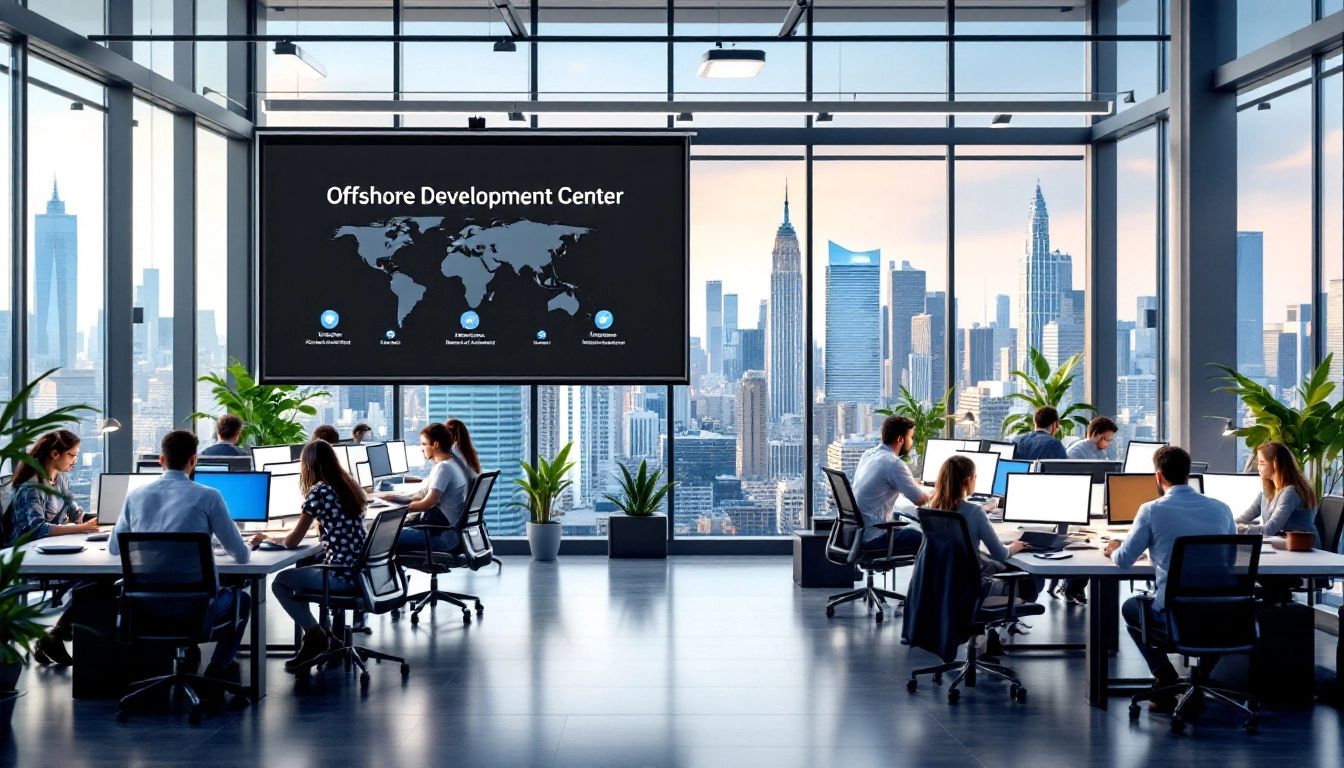Discover the power of offshore development centers (ODCs). Our comprehensive guide explores the benefits, challenges, costs, and best practices for setting up and managing a successful ODC. Learn how to leverage global talent, reduce costs, and accelerate your software development projects.

An offshore development center (ODC) is like a satellite office for your company, but located across borders. It’s a team of software developers and IT experts working solely on your projects, often in a different time zone. Think of it as an extension of your in-house team, just located overseas.
Unlike traditional outsourcing, where a project is handed off, an ODC gives you more control. You’re directly involved in choosing the team, managing the project, and handling the daily workflow.
Many companies choose this model to access a worldwide pool of talent and reduce costs. For instance, a US-based company might set up an ODC in a country like India or Ukraine to find skilled developers at a lower cost.
There are two main types of ODCs:
Whichever model you choose, an ODC is designed to fit your specific needs, from the team’s makeup and security protocols to project management approaches.
🔗 Get Started with DocuWriter.ai
Why are more and more companies considering the offshore development center model? Let’s look at the advantages:
1. Cost Savings: One of the biggest appeals is the potential to significantly lower development expenses. Salaries and operating costs in many offshore locations are less than in countries like the US or UK.
2. Access to a Global Talent Pool: An ODC opens the door to a wider range of skilled software engineers, designers, and testers. This is especially helpful in today’s tough tech job market, where finding the right people can be a challenge.
3. Focus on Core Business: By handing off development work to a dedicated team, you free up your in-house staff to concentrate on essential business activities like strategy, marketing, and innovation.
4. Faster Time-to-Market: With a dedicated ODC, you can potentially speed up development cycles. This is because you have a team solely focused on your projects, often working in a different time zone, which can lead to faster turnaround times.
5. Scalability and Flexibility: An ODC makes it easy to adjust your team’s size as project needs change. This flexibility is invaluable, especially for businesses with project requirements that go up and down.

Creating an offshore development center is a big decision that needs careful planning and execution. Here’s a breakdown of the main steps:
1. Define Your Needs and Goals: What do you want to achieve with an offshore development center? Clearly define your objectives, project scope, and what you want your team to look like. This clarity will guide your choices throughout the process.
2. Location, Location, Location: Picking the right location is crucial. Think about factors like time zones, the cost of living, the available talent, language skills, and the overall business environment. For example, if you need a team specializing in AI and machine learning, you might consider locations known for their strength in these areas, like Poland or Ukraine.
3. Choose Your Model: Will you go with a contractor ODC or a customer ODC? Each has its advantages and disadvantages in terms of control, cost, and administrative work. A contractor ODC might be a better fit for smaller companies or shorter projects, while a customer ODC offers more control but requires a larger investment.
4. Find the Right Partner (If Applicable): For contractor ODCs, do your research and choose a well-regarded vendor with a solid track record. Look for experience in your industry, good communication practices, and a strong commitment to security.
5. Infrastructure and Setup: This includes setting up office space, IT systems, communication channels, and security measures. Make sure data can be exchanged smoothly and that everything is compatible with your current systems.
6. Team Building and Onboarding: Carefully select your team members, thinking about their technical skills, experience, and how well they’ll fit in with your company culture. A solid onboarding process that includes training and clear communication rules is essential for the team to work well together.
7. Establish Communication Channels: Open communication is key. Set up regular meetings, use project management tools, and ensure everyone understands their roles and responsibilities.
8. Monitor and Evaluate: Regularly check the ODC’s performance against your initial goals. This means tracking key performance indicators (KPIs), getting feedback, and making changes as needed.
🔗 Get Started with DocuWriter.ai
Building a successful offshore development center (ODC) is about more than just setting up in a new place. It takes careful management to overcome geographical distances and cultural differences. Here’s how to make sure your ODC runs well:
1. Communication is King: Clear and regular communication is vital. Use a mix of tools like video conferencing, instant messaging, and project management software to keep everyone informed. Schedule regular meetings, being mindful of potential time zone differences.
2. Foster a Strong Team Culture: Even though your ODC team is located elsewhere, it’s crucial to make them feel like part of your company culture. Organize team-building activities, encourage knowledge sharing, and celebrate successes together.
3. Invest in Onboarding: A thorough onboarding process will set your ODC up for success. Provide clear documentation, training materials, and dedicated points of contact to help new team members adjust quickly.
4. Set Clear Expectations and Metrics: Define project goals, deliverables, and performance indicators right from the start. This clarity ensures everyone is on the same page about what success looks like and how it will be measured.
5. Embrace Cultural Sensitivity: Be aware of cultural differences in communication styles, work ethics, and holidays. This understanding builds respect and leads to smoother collaboration.
6. Regular Performance Monitoring: Regularly evaluate the ODC’s performance against established KPIs. Conduct performance reviews, gather feedback, and be ready to make adjustments to improve team dynamics and project outcomes.
Remember, managing an offshore development center is an ongoing process. By implementing these best practices and nurturing strong relationships, you can create a thriving ODC that makes a real difference to your business goals.
While offshore development centers (ODCs) offer attractive benefits, they also come with their own set of obstacles. Overcoming these challenges is essential to reaping the rewards of this model.
One common concern is communication and cultural differences. Working across time zones takes extra effort to ensure clear communication and understanding. Regular meetings, project management tools, and cultural sensitivity training can help bridge these gaps. For example, using video conferencing for face-to-face interactions can significantly improve communication and build stronger relationships.
Another challenge is quality control and project management. When you’re physically distant from your ODC, maintaining consistent quality standards requires strong processes. Clearly defined KPIs, rigorous testing procedures, and regular performance monitoring are essential. Many companies find that using Agile methodologies, which emphasize iterative development and frequent communication, helps manage offshore projects effectively.
Security risks, particularly regarding data protection and intellectual property, are also a concern. It’s crucial to choose an ODC partner with strong security measures in place and a proven commitment to data privacy. This includes secure data transmission protocols, access controls, and clear agreements about who owns intellectual property.
By addressing these challenges proactively with the right strategies and a dependable partner, you can unlock your offshore development center’s full potential and achieve your business goals.
🔗 Get Started with DocuWriter.ai

The offshore development center (ODC) landscape is always changing. New technologies and evolving business needs are shaping the future of how companies approach offshore development.
One notable trend is the rise of specialization. ODCs are increasingly focusing on specific areas like AI, machine learning, blockchain, and cybersecurity. Companies are looking for ODCs with expertise in these particular domains to gain a competitive advantage.
Another trend is the growing emphasis on Agile and DevOps practices. ODCs are adopting these methodologies to make development more efficient, improve communication, and shorten the time it takes to bring products to market.
Moreover, the demand for transparency and security is greater than ever. Companies are prioritizing ODC partners who offer strong security measures, clear communication, and a commitment to protecting data privacy.
As the reliance on technology grows, the need for efficient and cost-effective software development will only increase. ODCs are well-placed to meet this demand, but staying competitive requires embracing these evolving trends.
Speaking of staying ahead of the curve, have you thought about how AI can simplify your documentation process? Explore DocuWriter.ai to see how this powerful tool can automate your code and API documentation, freeing up your development team to focus on what they do best – building great software.